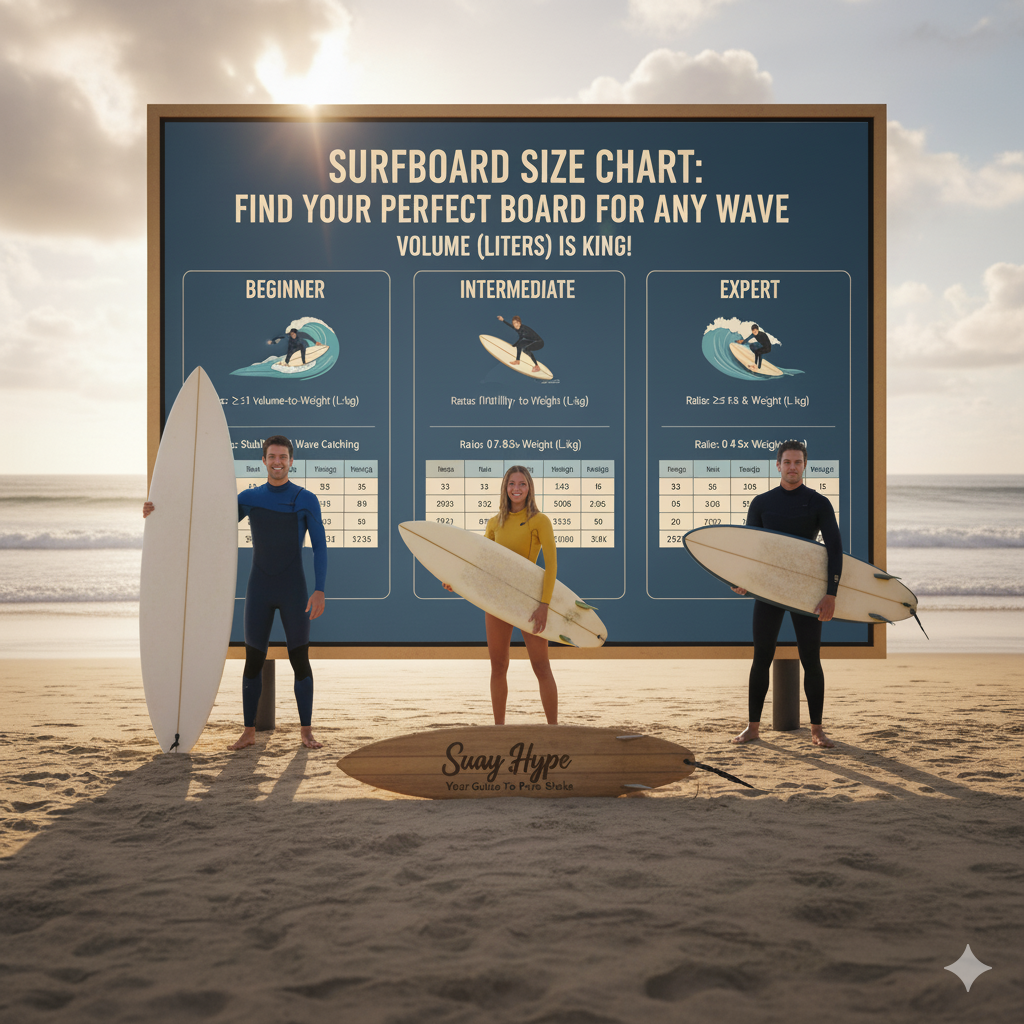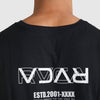Taille de planche de surf : trouvez la planche parfaite pour toutes les vagues

À retenir : le volume (en litres) est le critère le plus important d’une planche, bien plus que la longueur. Les débutants devraient viser un ratio volume/poids de 1:1 (ex : surfeur de 80 kg → ≥80 L) pour garantir une flottabilité maximale. Résultat : la rame est plus facile, plus de vagues, progression accélérée. Choisir la bonne taille, c’est éviter la frustration et gagner en confiance dès les premières sessions.
Tu galères à prendre des vagues en surf ? Le problème ne vient peut-être pas de ta technique, mais tout simplement de la taille de ta planche. Beaucoup de surfeurs pensent manquer de niveau alors qu’ils utilisent juste des dimensions inadaptées. Ce guide simplifie tout : tu vas comprendre comment ton poids, ton niveau et les conditions locales influencent le choix de la taille idéale de ta planche de surf.
Découvre les ratios volume-poids parfaits (1:1 pour débutants, 0,7–0,8 pour intermédiaires, 0,4–0,5 pour experts) et des tableaux faciles à lire adaptés à chaque profil. Apprends comment la longueur, la largeur et le volume impactent la stabilité et la vitesse, pour ramer plus efficacement, te lever plus facilement et choper plus de vagues. Fini les approximations : juste du plaisir pur à chaque session.
Pourquoi la bonne taille de planche est la clé pour améliorer ton surf
La différence entre galère et pur plaisir
Imagine choper ta première vague sans effort. Maintenant imagine ramer comme un fou et tomber à chaque take-off. La différence ? La taille de ta planche. La plupart des débutants abandonnent non pas par manque de talent, mais parce qu’ils surfent une board inadaptée. La bonne taille transforme la frustration en pur bonheur.
Choisir la bonne planche n’est pas une question de talent, mais d’équipement adapté. Une board bien dimensionnée rend l’apprentissage fluide et fun. C’est la base de toute progression. Si tu sautes cette étape, tu vas accumuler les galères.
Bien plus que ta taille
Le poids et le volume sont les facteurs clés. Un débutant a besoin d’un volume équivalent à son poids en kilos. Exemple : un surfeur de 70 kg devrait viser 70–90 litres. Plus de volume = plus de flottabilité et plus de stabilité. C’est le secret pour attraper des vagues facilement.
Ton niveau change tout. Les novices ont besoin de plus de volume pour rester stables. Les surfeurs avancés utilisent moins de volume pour gagner en maniabilité. Le type de vagues joue aussi : petites vagues molles = plus de volume ; vagues puissantes = moins. Adapte ta planche aux conditions pour un max de fun.
Les tableaux de tailles incluent longueur, largeur, épaisseur et volume. Le volume en litres est le chiffre à ne jamais ignorer. C’est lui qui détermine ta flottabilité. Toujours le vérifier avant d’acheter une planche. C’est ton meilleur indicateur.
Comprendre le volume : le plus important de ta planche
Qu’est-ce que le volume et pourquoi il change tout ?
Le volume, mesuré en litres (L), correspond à l’espace que prend ta planche. C’est un peu comme la cylindrée d’un moteur : plus il y en a, plus ça flotte.
Plus de volume rend la rame plus simple et t’aide à prendre plus de vagues. Pour les débutants, c’est synonyme de progression plus rapide. Beaucoup l’oublient et choisissent une planche trop petite.
Le volume est indiqué sous la planche. C’est la mesure la plus fiable de la flottabilité. Deux planches de taille identique peuvent avoir des volumes très différents. Toujours vérifier ce chiffre.
Ignorer le volume ralentit énormément la progression. Commencer avec plus de volume te donne confiance et te garde motivé à l’eau.
Trouver ton ratio volume-poids idéal
Ton poids et ton niveau déterminent ton volume idéal. Le ratio volume/poids est la règle d’or.
- Débutants : Volume (L) ≥ poids (kg). Exemple : 80 kg → minimum 80 L.
- Intermédiaires : 0,7–0,8 × poids. Exemple : 80 kg → 56–64 L.
- Avancés : 0,4–0,5 × poids. Exemple : 80 kg → 32–40 L.
Ces ratios assurent une flottabilité optimale selon ton niveau, évitant la fatigue rapide et les sessions frustrantes.
Les conditions jouent aussi un rôle. Petites vagues molles = plus de volume. Vagues puissantes = besoin de stabilité, surtout pour les débutants qui ont besoin d’un surplus de flottabilité pour choper des vagues régulièrement.
Utilise notre calculateur de volume pour trouver le volume de ta planche de surf exact adapté à ton gabarit et à ton spot local.
Commencer avec plus de volume garantit plus de vagues et te permet de te concentrer sur la technique. Tu progresses plus vite et tu restes motivé, chaque session devient un vrai plaisir.
Le guide ultime des tailles pour débutants
Comment lire les dimensions d’une planche
Comprendre les dimensions d’une planche t’évite des erreurs et accélère ta progression. Pour les débutants, le volume doit être la priorité pour faciliter la rame et les premiers take-offs.
- Longueur : 8'+ = très stable ; plus court = plus maniable. Pour commencer, le long c’est mieux.
- Largeur : 21"+ = meilleur équilibre, moins de risque d’enfoncer la board.
- Épaisseur : 2,5"+ = boost de flottabilité pour ramer sans forcer.
- Volume : vise 100–120 % de ton poids pour une flottabilité optimale.
Largeur + épaisseur = stabilité. Le volume combine tout pour donner un comportement idéal.
Recommandations funboard & longboard
Ce tableau aide les débutants à choisir selon le poids et la fréquence de surf. Exemple : surfeur de 150 lbs (≈68 kg) qui surfe toutes les semaines : 7'2"–7'8". Les surfeurs quotidiens peuvent descendre un peu en taille.
| Poids du surfeur (Lbs / Kg) | Fréquence de surf | Longueur recommandée (Funboard / Longboard) |
|---|---|---|
| 100–140 Lbs (45–63 kg) | 1–2 sessions/semaine | 7'0" - 7'4" |
| 100–140 Lbs (45–63 kg) | >2 sessions/semaine | 6'4" - 7'2" |
| 140–160 Lbs (63–72 kg) | 1–2 sessions/semaine | 7'2" - 7'8" |
| 140–160 Lbs (63–72 kg) | >2 sessions/semaine | 6'8" - 7'4" |
| 160–180 Lbs (72–81 kg) | 1–2 sessions/semaine | 7'6" - 8'0" |
| 160–180 Lbs (72–81 kg) | >2 sessions/semaine | 7'2" - 7'8" |
| 180–200 Lbs (81–90 kg) | 1–2 sessions/semaine | 7'10" - 8'4" |
| 180–200 Lbs (81–90 kg) | >2 sessions/semaine | 7'6" - 8'0" |
| 200+ Lbs (90+ kg) | 1–2 sessions/semaine | 8'2"+ |
| 200+ Lbs (90+ kg) | >2 sessions/semaine | 7'10"+ |
La bonne taille réduit la frustration. Un bon volume signifie plus de vagues, des take-offs plus faciles et plus de fun. Vérifie toujours les specs selon ton poids et ton niveau.
Ajuster ton choix : vagues locales et formes de planches
Adapter ta board à ton spot
Le volume (en litres) est essentiel pour flotter correctement. Plus de volume = meilleure flottabilité, parfait pour débutants et petites vagues. Pas assez de volume = rame fatigante et vagues difficiles à attraper. Le volume compte encore plus que la longueur, car il dépend aussi de la largeur et de l'épaisseur. Plus de volume rend l’apprentissage plus facile, grâce à une meilleure stabilité et des take-offs facilités.
La bonne planche, c’est surtout celle qui correspond à tes vagues. Une board faite pour les vagues puissantes sera nulle dans du petit surf. Par exemple, un shortboard dans des vagues molles n’aura pas la vitesse nécessaire pour partir, et c’est la frustration assurée.
Le volume varie selon la largeur et l’épaisseur. Adapte toujours selon ton poids et ton niveau : les débutants ont besoin de plus de volume que les surfeurs confirmés. Petites vagues = plus de volume ; vagues puissantes = moins de volume pour garder du contrôle. Toujours vérifier les tableaux de volume avant d’acheter.
Petites vagues molles : 50+ L aident énormément pour ramer et partir sur les vagues. Le volume compense le manque de puissance de la vague, sauvant tes sessions les jours mous.
Vagues puissantes : 30–40 L donnent meilleur contrôle et facilité à passer la barre. Moins de volume = plus de réactivité.
Guide des types de planches
- Longboards (9'+) : 50–80+ L pour une stabilité maximale. Idéal pour débuter ; les gabarits lourds devraient viser 9'6" et plus.
- Funboards (7'–8'6") : 45–60 L, un équilibre parfait entre stabilité et maniabilité. Top pour progresser dans des petites à moyennes vagues.
- Fish (5'4"–6'4") : 30–45 L, larges et rapides dans le petit. Parfait pour s’amuser dans le mou.
- Shortboards (5'6"–6'6") : 25–40 L pour surfeurs avancés ; peu de volume = rame exigeante mais maniabilité maximale.
Le choix dépend de ton poids, ton niveau et ton spot. Priorise le volume plus que la longueur pour une progression fluide. Et n’hésite pas à demander conseil en surf shop pour un choix ultra personnalisé.

Éviter les erreurs courantes et progresser sereinement
L’erreur numéro 1 : passer trop vite à une petite planche
L’une des plus grosses erreurs chez les débutants, c’est de vouloir surfer un shortboard trop tôt. On voit les pros envoyer des manœuvres avec des petites boards et on veut faire pareil… mais c’est le meilleur moyen de freiner sa progression. Les petites planches rament moins bien, prennent moins de vagues et demandent un équilibre bien plus précis. Tu vas passer plus de temps à lutter qu’à apprendre. Une planche plus grande t’offre flottabilité et stabilité, te permettant de te concentrer sur les bases : take-off, lecture de vague, direction. Une board avec assez de volume t’aide à te lever proprement et à rester debout plus longtemps, réduisant la frustration des premières sessions. Respecter la progression et choisir le bon matos, c’est la clé pour réellement progresser.
Ta planche parfaite existe vraiment
Trouver la planche parfaite commence par le volume. Utilise notre tableau comme point de départ, puis adapte selon ton poids, ta taille et ton spot. Les débutants profitent toujours de plus de volume pour ramer facilement et rester stables. Les vagues influencent aussi : petites vagues = plus de volume, vagues puissantes = boards plus petites. En progressant, tu pourras réduire la taille pour gagner en réactivité. Comprendre tous les termes du surf t’aide à mieux choisir ton matériel et à te sentir plus connecté à la communauté surf. L’océan, c’est la liberté, la simplicité, et une vraie connexion avec la nature. Suay Hype t’accompagne pour trouver la planche parfaite pour ton voyage surf personnel.
Le choix de la bonne taille de planche est la base d’une progression solide et plaisir. Donne la priorité au volume, utilise notre tableau, et adapte ton choix à ton spot. Ne passe pas trop vite à des petites boards la progression demande de la patience. Surfe avec confiance et maîtrise le vocabulaire en découvrant tous les termes du surf. Suay Hype t’accompagne à chaque vague.






